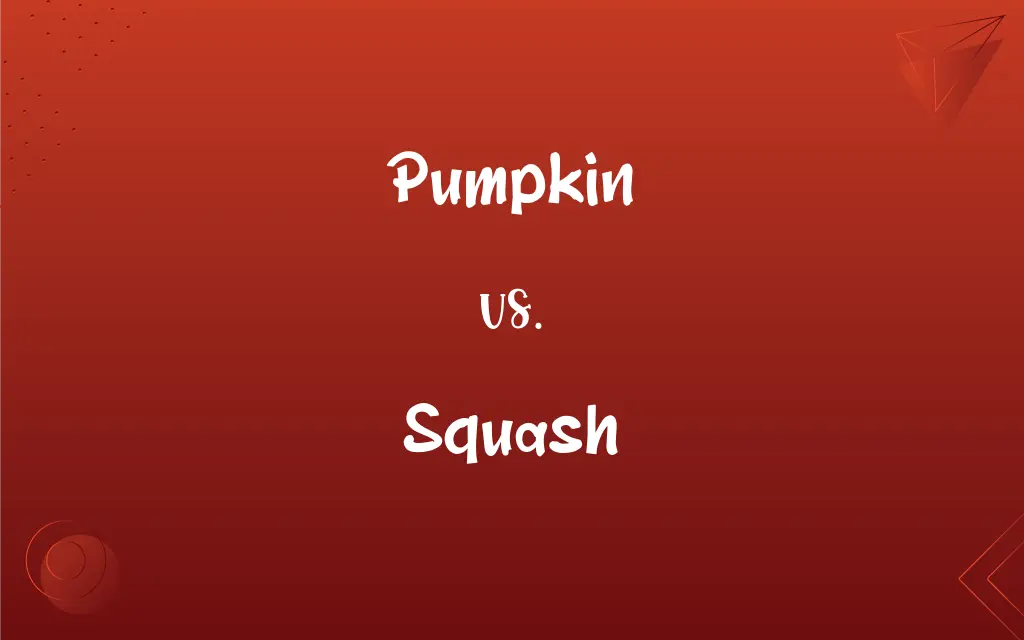Pumpkin vs. Squash: What's the Difference?
Edited by Aimie Carlson || By Janet White || Published on December 24, 2023
Pumpkins are a type of squash, specifically characterized by their round shape and orange color, while squash is a broader category including various shapes, sizes, and colors.

Key Differences
Pumpkins and squash both belong to the Cucurbitaceae family, but pumpkins are specifically classified under the genus Cucurbita. Squash, on the other hand, encompasses a wider range of species within the same family, making it a more inclusive category.
Pumpkins are often associated with specific varieties used for carving and cooking, while squash encompasses a diverse range of types, including summer and winter squash. This diversity in squash leads to a broader spectrum of culinary uses compared to the more specialized use of pumpkins.
Pumpkins are generally round and orange, a familiar image during Halloween and Thanksgiving. Squash varies greatly in shape, size, and color, ranging from elongated zucchinis to acorn squash with unique patterns and hues.
The pumpkin has a significant cultural presence, especially in American traditions like Halloween and Thanksgiving. Squash, while widely consumed, does not have the same iconic status and is more celebrated for its culinary versatility.
Both pumpkins and squash are nutritious, offering vitamins, minerals, and fiber. However, the specific nutritional content varies among different types of squash, whereas pumpkins have a more consistent nutritional profile, being particularly high in vitamin A.
ADVERTISEMENT
Comparison Chart
Classification
A specific type of squash
A broad category of plants
Shape
Typically round
Varies widely (round, elongated, etc.)
Color
Generally orange
Range of colors (green, yellow, orange, etc.)
Cultural Significance
Strongly associated with Halloween and Thanksgiving
Less culturally specific, diverse uses
Nutritional Content
High in vitamin A, relatively consistent
Varies widely among types
ADVERTISEMENT
Pumpkin and Squash Definitions
Pumpkin
A large, round, orange fruit of a trailing plant, typically used for decoration or cooking.
We carved the pumpkin into a jack-o'-lantern for Halloween.
Squash
To crush or flatten something with force.
He accidentally squashed the bug with his shoe.
Pumpkin
The color of pumpkin, a deep orange.
She wore a dress in pumpkin, matching the autumn leaves.
Squash
Suppress or overcome something completely.
The rebellion was quickly squashed by the government.
Pumpkin
The plant that produces the large orange fruit, belonging to the gourd family.
The pumpkin vine in our garden has started to flower.
Squash
A plant and its fruit of the gourd family, with many varieties.
We grew summer squash in our backyard this year.
Pumpkin
Something resembling a pumpkin in shape or color.
The toddler wobbled around like a little pumpkin.
Squash
Make room or space for something by compressing.
We all squashed into the car for the road trip.
Pumpkin
Used as an affectionate term of address.
Goodnight, pumpkin, she whispered to her child.
Squash
A game played in an enclosed court with rackets and a small rubber ball.
They played squash at the sports club every weekend.
Pumpkin
A round, often large squash with coarse, strongly flavored yellow to orange flesh, numerous seeds, and a moderately hard, usually orange rind.
Squash
Any of various bushy or vining plants of the genus Cucurbita, having unisexual flowers and fleshy edible fruit with a thick rind when mature.
Pumpkin
Any of several plants producing these fruits, especially varieties of the species Cucurbita pepo, and also varieties of C. maxima and C. moschata.
Squash
The fruit of any of these plants, eaten as a vegetable.
Pumpkin
A moderate to strong orange.
Pumpkin
A domesticated plant, in species Cucurbita pepo, similar in growth pattern, foliage, flower, and fruit to the squash or melon.
Pumpkin
The round yellow or orange fruit of this plant.
Pumpkin
(uncountable) The color of the fruit of the pumpkin plant.
Pumpkin
(Australia) Any of a number of cultivars from the genus Cucurbita; known in the US as winter squash.
Pumpkin
(US) A term of endearment for someone small and cute.
Pumpkin
A well-known trailing plant (Cucurbita pepo) and its fruit, - used for cooking and for feeding stock; a pompion.
Pumpkin
A coarse vine widely cultivated for its non-keeping large pulpy round orange fruit with firm orange skin and numerous seeds; subspecies of Cucurbita pepo include the summer squashes and a few autumn squashes
Pumpkin
Usually large pulpy deep-yellow round fruit of the squash family maturing in late summer or early autumn
FAQs
What is the main use of pumpkins in the United States?
In the U.S., pumpkins are primarily used for carving and cooking, especially during Halloween and Thanksgiving.
Do squash have different growing seasons?
Yes, there are summer and winter squash, indicating their growing seasons and harvest times.
Can squash be used in savory dishes?
Yes, squash is versatile and can be used in both savory and sweet dishes.
Are pumpkins only orange?
While orange is the most common color, pumpkins can also be white, green, or multi-colored.
Can pumpkins be used for baking?
Yes, pumpkins are commonly used in baking pies, bread, and other desserts.
Is squash high in any particular nutrients?
Squash is generally high in vitamins A and C, fiber, and potassium.
What family do pumpkins and squash belong to?
Both belong to the Cucurbitaceae family.
Are all squash edible?
Most squash varieties are edible, though some are more palatable than others.
Are there decorative varieties of squash?
Yes, some squash varieties are grown primarily for decorative purposes.
Can pumpkins be grown in a home garden?
Yes, pumpkins can be grown in a home garden, provided there is enough space for their vines.
Can pumpkins be eaten?
Yes, pumpkins are edible and often used in cooking.
What is the difference between pumpkin pie spice and actual pumpkin?
Pumpkin pie spice is a blend of spices used to flavor dishes, while actual pumpkin is the fruit itself.
Are there heirloom varieties of pumpkins and squash?
Yes, there are many heirloom varieties of both, prized for their unique flavors and characteristics.
Is it possible to eat the skin of squash?
The skin of some squash varieties is edible, especially when cooked, but it depends on the type and maturity of the squash.
Is there a nutritional difference between pumpkins and squash?
Yes, the nutritional content varies, especially among different types of squash.
What is a common type of summer squash?
Zucchini is a popular type of summer squash.
Are pumpkins a type of fruit or vegetable?
Botanically, pumpkins are a fruit, but they are often used as vegetables in cooking.
Are pumpkin seeds edible?
Yes, pumpkin seeds are edible and often roasted for a snack.
What is a common use for butternut squash?
Butternut squash is often used in soups and roasted dishes.
Can both pumpkin and squash be pureed for recipes?
Yes, both can be pureed and are commonly used in soups, pies, and sauces.
About Author
Written by
Janet WhiteJanet White has been an esteemed writer and blogger for Difference Wiki. Holding a Master's degree in Science and Medical Journalism from the prestigious Boston University, she has consistently demonstrated her expertise and passion for her field. When she's not immersed in her work, Janet relishes her time exercising, delving into a good book, and cherishing moments with friends and family.
Edited by
Aimie CarlsonAimie Carlson, holding a master's degree in English literature, is a fervent English language enthusiast. She lends her writing talents to Difference Wiki, a prominent website that specializes in comparisons, offering readers insightful analyses that both captivate and inform.






































































